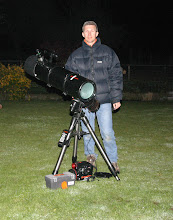While I’m slowly finishing the Herschel II list, I decided to go for a new challenge, the Fred 200 planetary list. Fred H is a Dutch astronomer who has extensive experience in drawing planetary nebula’s. He has seen 280 planetary nebulas with a 20cm scope (from Holland!). To honor this achievement a list of 200 of those objects has been compiled by his Dutch peers and called it to his name: “Fred’s 200 planetary nebulas”.
You can find this list here.
One of the reasons I selected this challenge is to observe something else than galaxies. The last 5 to 10 sessions has been almost exclusively dedicated to galaxies. It’s time to get some variation in the program. This does not mean I will exclude galaxies, as one of the aim of tonight was … yes, a group of galaxies, Seyfert’s Sextet.
Date: May 30, 2009
Location: Boutersem
Equipment: Obsession 18”
Eyepieces: 24mm; 16mm, Powermate 2,5x
Nelm: 5.0
Seeing: good
Time 22:30Hr UT to 00Hr00UT. Clouds appearing at 0:00.
I have a difficult start. The batteries of the Argo Navis do not seem to give any power. In the dark it’s difficult to see that one of the wires is disconnected … Next issue, the Servo Cat does not power up. This happens now and then, it’s one of the cables in the box which is not well plugged in.
OK, we are ready to go. M5, the globular in Serpens Caput is the first on the list. This is a beautiful global, maybe even nicer than M13.
Next is Seyfert’s Sextet:
NGC 6027 – Seyfert’s Sextet – group of galaxies in Serpens Caput
Really difficult. Also because the moon is still disturbing a bit. At 124x I can see with a lot of effort an oval spot of 2’. At 316x the B component of the group is clearly visible. Maybe I have seen the A component too, but this is not sure. The group is located in between two 14th magnitude stars.
NGC 5921 – galaxy in Serpens Caput
At 211x NGC 5921 is an oval of 2’ with a bright core. Could not see the bar.
Time for 2 objects in Hercules from Fred’s 200 list.
PK 51 +9.1 (Hu 2-1) – planetary in Her
Hu 2-1 is a mag 12.2 object with a size of 2”. In other words, it’s tiny. It’s easily visible at 124x as a stellar object. It reacts positively with an UHC filter. At 211x it’s bright, white and a very faint disc is visible. The centre looks brighter, could this be the central star?
PK 53 +24.1 (Vy 1-2) – planetary in Her
This planetary is of magn 12.3 and is 4”6 small. It easily visible as a bright star at 124x. Did not look at 211x.
Cygnus is now high enough in the sky, a good moment to finalize the 5 open clusters from the HII list.
NGC 6991 – open cluster in Cyg
NGC 6991 is one of those objects in the Dreyer catalogue of which the location is not well defined. On the NGCIC project 2 locations, close to each other are mentioned. So I’ve been looking at both of them. The first location is a few minutes west of mag 5.6 star (HR 8020). Strange enough there is almost nothing to see there, even at high power. It’s just an area with a few stars, not even concentrated. The 2nd location is South West of this bright star. Here indeed a loose group of 20 stars, in an area of 15’ is visible. This group contains 2 short chains of 3 stars.
NGC 6997 – open cluster in Cyg
NGC 6997 is an open cluster of the HII list. Here also there is some confusion on its precise locations. Some catalogues are inverting NGC 6997 with NGC 6996. So here again I observed the 2 spots: The most northern one (+45°28’) is a very small group of 10 stars in an area of 5’ (84x). The other one (at +44°37’) is a group of 20’ with 20 stars. Most of them are of the same brightness.
NGC 7067 – open cluster in Cyg
Is this an open cluster? At 211x I can see 10 stars west from a bright triple star (SAO 50808, the primary is of magn 9,41). But this does not look like a concentration of stars. The area contains a bright double star. After checking the DSS picture I conclude I’ve probably not been looking at the right location. I will log it as not seen.
NGC 7082 – open cluster in Cyg
Observed when clouds are appearing. This is a group of 50 stars (probably more if there were no clouds). The edges of the group is not easy to define because this group is just a little be more concentrated than its surrounding field. The 2 brightest stars are yellow. North, perhaps already out of the group, is another bright yellow star. I think I’ve seen a faint red star too, but this is not sure as the group is fading away behind the clouds. These colors are not mentioned in the 11 observation in dslog, so is this just imagination or is it a side effect due to the clouds?
HII: observed 347 out of 400
Subscribe to:
Post Comments (Atom)
+v2.jpg)
2 comments:
What an amazing sky tour you've provided!!
the Lens collection for sale is a great one.
I am also so much interested in Astronomy... and after I saw your blog... my attraction towards stars and galaxies .. just doubled... very nice post.
Post a Comment